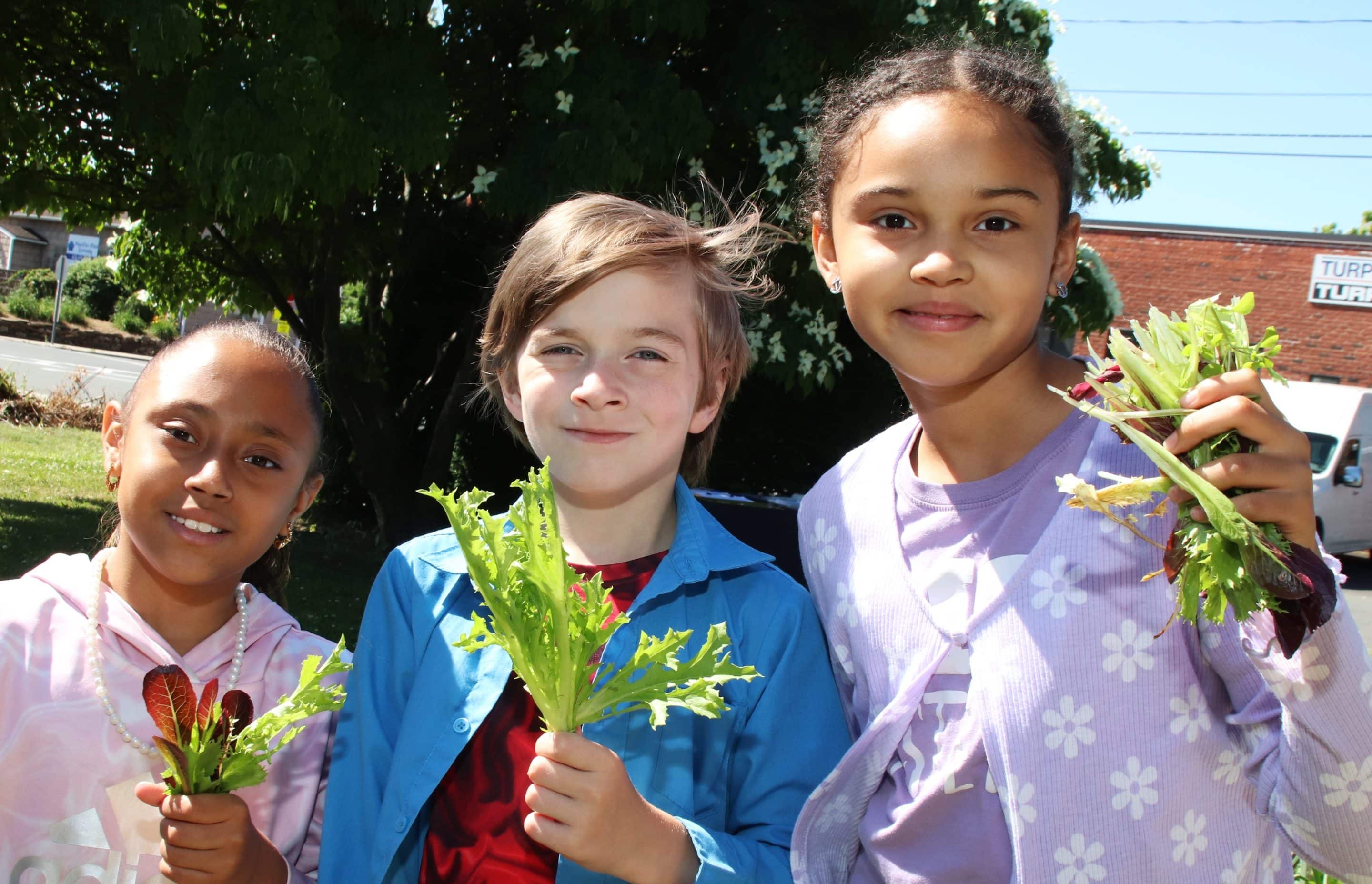From left, Mayaliz Leon, Marshall Provencher and Alma Avendano — all third graders at the Memorial School — hold freshly picked lettuce from the school’s community garden.
Reminder Publishing photo by Mike Lydick
WEST SPRINGFIELD — The last week of the school year was very exciting Alma Avendano, a third grader at Memorial School in West Springfield. Not only would summer vacation start soon, but she was harvesting lettuce that she had helped to grow in the school’s community garden.
“I’m very excited about picking the lettuce — it’s so good to eat fresh produce,” said the 9-year-old after her class harvested lettuce on June 10. “It’s great to be able to grow vegetables and then eat them a couple of months later.”

Reminder Publishing photo by Mike Lydick
She and the other 198 students at the elementary school ate salads for lunch later that week made with 25 pounds of lettuce they had harvested from one of several garden beds in front of the school. In addition to the salad tasting event, there is a roasted root vegetables tasting day for students and staff in late fall
“I have never seen students get so excited about lettuce. It’s amazing to see them try new things and to be more comfortable doing so the more years they participate,” said Katherine Metzger, a garden coordinator who works for a Supplemental Nutrition Assistance Education program at the nonprofit Ascentria Care Alliance.
Metzger said the SNAP-Ed program teaches nutrition education to youngsters in low-income communities throughout Hampden County. It’s funded by the Massachusetts Department of Transitional Assistance, as well as a Farm to School grant from the U.S. Department of Agriculture.
Although Metzger and her colleagues help coordinate a variety of community gardens in the area, she said the ones they do the most work with — and are most proud of — are the school gardens in West Springfield. In addition to Memorial School, they also manage school gardens at John Ashley Kindergarten, Mittineague School and West Springfield Middle School.
“The gardens at Memorial and Mittineague schools are our longest running and most established,” said Metzger, who has been working with the school gardens since 2021. “We’ve built the garden programs with a lot of help and support from teachers, administrators, students, families and community members.”
Third grader Girish Chhetri said he likes the garden program because the vegetables are fresher than what’s available at grocery stores.
“They’re more nutritious and eating them helps make you healthier, too,” he said.
Every student at Memorial and Mittineague gets to come out to the gardens to do hands-on work at least three times a year. In late March or early April, they plant quick-growing crops that can grow in cool weather, such as lettuce, kale, spinach, radishes and sugar snap peas.
In June, they harvest the spring crops and plant crops that will grow all summer and will be ready for students to harvest in the fall. These include potatoes, carrots, beets, corn, squash and beans.
Fifth grader Prayas Bhujel enjoys planting more than harvesting.
“I love planting because I get to put seeds in the ground and watch them grow so I can eat them when they’re fresh,” said the 11-year-old.
“We got this school garden planting/harvesting/tasting events model from a gardening nonprofit in Gloucester, Massachusetts, called Backyard Growers,” said Metzger. “It maximizes using the small amount of time that the school year and growing season overlap. It’s a constant challenge for school gardens, since the height of the growing season is when students are not at school.”
Metzger said that with the help of the USDA grant, Memorial School this year piloted a “Harvest of the Month” program. School meals included — and highlighted — a different local vegetable every month.
In addition to what’s grown for harvest days and tasting events, there are a variety of other crops that can be picked whenever they’re ready to harvest.
“We encourage students, staff and families to visit the garden and harvest often,” said Metzger.
“Some favorite ‘pick whenever they’re ready to harvest’ crops in the school gardens are sugar snap peas, strawberries, mint, cucamelons, cherry tomatoes and sorrel,” she said. “Any vegetables left over from harvest events are given to students or the school community to take home.”
The garden program goes beyond the all-school planting and harvesting events. Metzger said while student involvement at each school looks different and constantly evolves, some examples include:
- WSMS English language learners grew plants under grow lights in their classroom and built their own raised beds this spring for the plants.
- Mittineague students used the garden to learn about reading and math.
- Each John Ashley classroom had its own days of the month to water the garden beds.
- Memorial School fifth graders designed and built their own compost bins.


